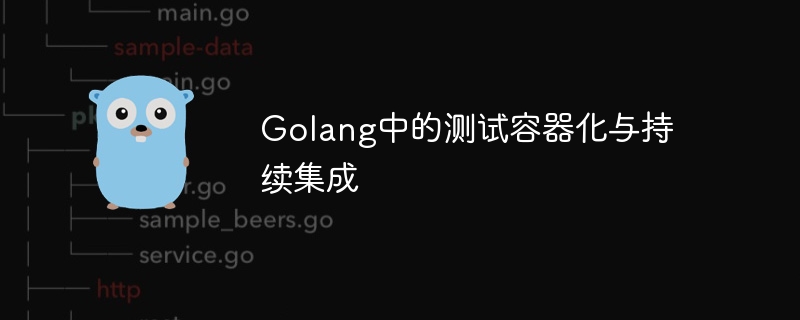

Test containerization and continuous integration in Golang
With the continuous evolution of the software development process, test containerization and continuous integration have become indispensable in modern software development. missing part. As a fast and efficient programming language, Golang also actively supports test containerization and continuous integration. This article will introduce how to containerize Golang testing and combine it with continuous integration tools to achieve an efficient development process.
Why test containerization and continuous integration?
Test containerization and continuous integration are one of the popular software development methods currently. Test containerization isolates an application from its dependencies, ensuring a consistent testing environment. This allows developers to run the same test suite in any environment, avoiding the problem of test failures due to inconsistencies in development environments.
On the other hand, continuous integration means that developers frequently merge code into the main code base and ensure the quality of the code through automated builds and tests. Continuous integration can quickly discover and solve problems in the code, reducing errors and bugs during the development process.
The benefits of test containerization and continuous integration are obvious: improving development efficiency, reducing error rates, and ensuring code quality. Next, we will use Golang and some common tools to achieve this goal.
Docker vs. Golang Test Containerization
Docker is a popular containerization platform that packages an application and its dependencies into a self-contained unit called a container. Using Docker allows you to run the same test suite in different environments to ensure test reliability.
First, we need to create a Docker image for our Golang application. We can define the build process of the Docker image by writing a file called Dockerfile. The following is a simple Dockerfile example:
FROM golang:1.15 WORKDIR /app COPY go.mod . COPY go.sum . RUN go mod download COPY . . RUN go build -o test-app . CMD ["./test-app"]
The above Dockerfile uses Golang's official Docker image and copies the source code in the current directory to the container's /app directory. It then downloads and builds the application's dependencies and finally builds the application using the go build command.
Next, we can use the following command to build the Docker image:
docker build -t test-app .
By using the above Dockerfile and build command, we can build a Docker image named test-app in the local environment .
Next, we can use the following command to run our application container:
docker run -it --rm test-app
Continuous Integration Practice
Before introducing continuous integration, let us first understand Travis CI, which Is a popular continuous integration tool.
First, we need to create a .travis.yml file for our project. Here is an example:
language: go go: - 1.15 script: - go test -v ./...
The above configuration file specifies the use of Golang 1.15 as the build environment and defines the script to run the tests.
Next, we need to push the code to the code repository hosted on GitHub. We can then connect to GitHub via the Travis CI website and enable continuous integration on our project.
After enabling continuous integration, whenever we push new code to GitHub, Travis CI will automatically download the latest code and run the defined test script.
Summary
By containerizing Golang tests and continuously integrating them, we can isolate the test environment from the application's dependencies and ensure the reliability of the tests. Continuous integration will automate the build and test process, improving development efficiency and code quality.
A basic example is provided in the above article, demonstrating the use of Docker and Travis CI to implement Golang test containerization and continuous integration. Readers can adjust and expand accordingly according to their own needs.
By testing containerization and continuous integration, we can develop and deliver high-quality Golang applications with more confidence. At the same time, this also provides a lot of convenience for teamwork and code maintenance.
I hope this article will help you implement test containerization and continuous integration in Golang!
The above is the detailed content of Test containerization and continuous integration in Golang. For more information, please follow other related articles on the PHP Chinese website!




